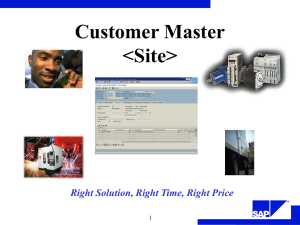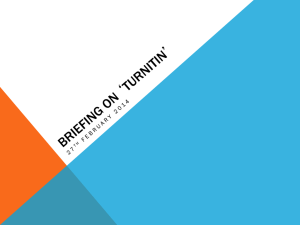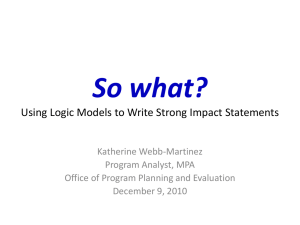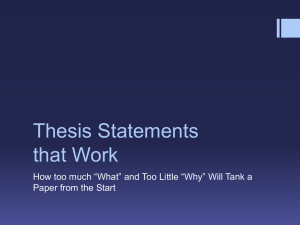Presentation
advertisement
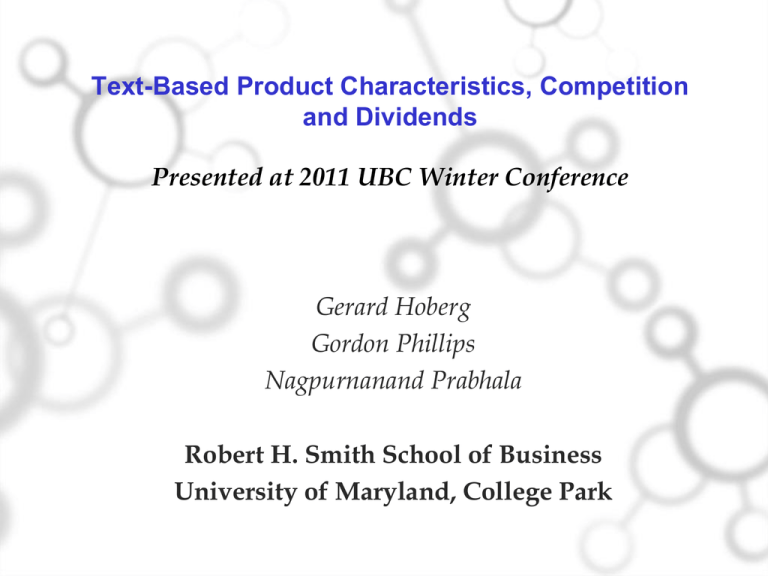
Text-Based Product Characteristics, Competition and Dividends Presented at 2011 UBC Winter Conference Gerard Hoberg Gordon Phillips Nagpurnanand Prabhala Robert H. Smith School of Business University of Maryland, College Park Research Question How the structure and evolution of a firm’s product space shapes its payout policy. Text to characterize product space Fluidity, competition, and product customer type Several payout decisions Propensity to pay dividends + initiations, omissions, changes. Repurchases Dividend-repurchase substitution 2 Motivation: Fluidity Brav, Graham, Harvey, Michaely (2005) “Sustainability and stability of future earnings are the most important determinants of payout” policy.” Sustainable earnings less likely in fluid product markets in flux due to rivals. 3 Blackberry Nexus S Smartphone Dell Streak Blackberry Playbook Sony S1 Tablets Toshiba Motorola Xoom Samsung Galaxy Acer Iconia LG Slate Motivation: Fluidity We construct a new metric of fluidity from product text. Why should this matter? Fluidity measures ex-ante threats. This can be quite different from measured ex-post cash flow risk and both can matter. Power. Product text is (a) voluminous; (b) timely. Thus, it contains detailed, forward looking information about product markets as seen by senior managers., AAPL “Music” “Phone” # words SIC 1999 0 0 867 3571 2009 24 35 3592 3571 6 Hypotheses H1: Fluidity - Firms facing fluid product markets are less likely to make payouts. Especially via dividends. H2: Competition and Differentiation - Firms with differentiated products and in more protected markets should be more likely to pay dividends. H3: Business (not investor) clientele - Business customers may value long-term stability to ensure stable supply chain. - If yes, then firms with more business (non-retail) clientele should prefer dividends over repurchases.. 7 Related Literature Product life cycle (Abernathy-Utterback, 1978) - Stable products and dominant designs late in life cycle favor payouts. Life cycle + agency (DeAngelo et al., 2009) - Mature firms pay out to avoid agency problems. - Competitive threat from product market fluidity makes disciplining dividends less necessary. Firm maturity: DeAngelo et al., 2006; Grullon et al, 2002 - Maturity is gradual ageing over life cycle. - But old, mature firms can also face fresh threats in the product market. We can pick these up. - Both can matter for payout. 8 Related literature Payout Policy Reviews by Allen and Michaely (2005), DeAngelo, DeAngelo, and Skinner (2009). CEO/CFO surveys by Lintner (1956), and Brav et al. (2005). Investor-driven clientele hypothesis finds weak support. Brav et al. (2005); Grinstein and Michaely (2005), Jain (2007). Dividends vs. Repurchases: Fama-French-2001, Grullon-Michaely-2002, or Jagannathan, Stephens, and Weisbach 2002. Choice boils down to managers’ view about permanence and stability of cash flows. 9 Related literature Text-Based Analysis Asset pricing applications are in Tetlock-2007, TetlockTsechanksy-Macskassy-2008, and Loughran-McDonald2010. Studies relate word content to stock price movements. The roots of this paper are in Hoberg-Phillips (2010a,b) - HP introduce product text to the corporate literature - We build on their work by introducing new metrics of fluidity and dynamics of product space 10 Data The guts of our sample is from HP - 49,000+ 10-Ks from 1997 to 2005 for product text - 10-Ks from 1996 only used for starting lagged variables. - 95%+ of eligible COMPUSTAT/CRSP sample Linguistics: Converting Text to Quantitative Mappings 1. Union of all words in product descriptions (87,385 in 1997) minus words in more than 5% of all 10-Ks (3027 in 1997) a. Optional: throw out words that are not part of “cliques.” b. Remaining “local” words are “industry vocabularies” 2. Form boolean vectors for all word vectors (1=word used, 0=not used). Normalize to unit length. 3. Compute “cosine similarities” or dot products of these 84,000 element vectors. 13 Cosine Similarity Hoberg and Phillips (2010a, 2010b) introduce the notion of cosine “similarity.” - Similarity is the dot product between a firm’s word list and another vector of words. - HP analyze firm-to-firm similarity for each year and reconstruct industry pairs. http://www.rhsmith.umd.edu/industrydata/index.html 14 Similarity in HP Firm 1: “They sell cabinet products.” Firm 2: “They operate in the cabinet industry.” Step 1) Drop words "they", "the", "and", "in" (common words). Step 2) 5 elements: "sell" "operate", "cabinet", "products", "industry" P1 = (1,0,1,1,0) P2 = (0,1,1,0,1) Vi Pi Step 3) Normalize vector to have unit length of 1: P .P V1 = (.577,0,.577,.577,0) V2 = (0,.577,.577,0,.577) i i Step 4) Compute document similarity V1 • V2 = .33333 Document similarity is bounded between (0,1) 15 Similarity for “Fluidity” We develop HP ideas of similarity along new directions. 1. Product Fluidity Cosine similarity between own word vector and a vector of word changes. - Local fluidity – based on close competitors - Broad fluidity – aggregate word change list. Note that it excludes 5% common words. 2. Self Product Fluidity 1- Cos(qit,it-1) (similarity of 10K to last years 10K) 3. Business Clientele Similarity See next slide 16 “Similarity” for Clientele Cosine similarity of own words to words in input-output matrix of industries that sell over 90% of their products to non-retail customers. PLASTICS RUBBER PULP PAPER PAPERBOARD TRANSPORTATION SUPPORT AGRICULTURE CONSTRUCTION MINING MACHINERY ACCOUNTING BOOKKEEPING SERVICES ADMINISTRATIVE SUPPORT SERVICES MOTOR VEHICLE BODIES TRAILERS PARTS HVAC COMMERCIAL REFRIGERATION EQUIPMENT CHEMICAL PRODUCTS INDUSTRIAL MACHINERY NONMETALLIC MINERAL GENERAL PURPOSE MACHINERY AGRICULTURAL CHEMICALS YARN FABRICS TEXTILE MILL PAINTS COATINGS ADHESIVES MAGNETIC MEDIA PRINTED ANIMAL AGRICULTURE FORESTRY SUPPORT SERVICES PIPELINE TRANSPORTATION TURBINE POWER TRANSMISSION EQUIPMENT AEROSPACE PARTS FABRICATED METAL WOOD WAREHOUSING STORAGE MANAGEMENT TECHNICAL CONSULTING SERVICES FORGINGS STAMPINGS EMPLOYMENT SERVICES PRIMARY FERROUS METAL ELECTRICAL EQUIPMENT BOILERS TANKS SHIPPING CONTAINERS METALWORKING MACHINERY BASIC CHEMICALS ADVERTISING RELATED SERVICES SEMICONDUCTORS ELECTRONIC COMPONENTS COAL NONMETALLIC MINERALS MACHINERY EQUIPMENT RENTAL LEASING ARCHITECTURAL STRUCTURAL METAL PRIMARY NONFERROUS METAL FOUNDRY 17 Fluidity Some Familiar Examples Microsoft (started dividends) Adobe Systems (stopped dividends) Apple Computers (never paid and still does not) 18 Microsoft Dividends and Fluidity 2.5 2 1.5 Dividend Payer Fluidity 1 0.5 0 1997 1998 1999 2000 2001 2002 2003 2004 2005 2006 Fluidity Dividend Payer 2007 2008 Adobe Dividends and Fluidity 1.8 1.6 1.4 1.2 1 Dividend Payer Fluidity 0.8 0.6 0.4 0.2 0 1998 1999 2000 2001 2002 2003 2004 2005 2006 Fluidity Dividend Payer 2007 2008 Apple Computers Marches To Its Own Beat 2 1.5 1 0.5 Payer Fluidity 0 1 -0.5 -1 2 3 4 5 6 7 8 9 10 Fluidity Payer 11 12 Dividends, Fluidity, and Clientele 0.7 0.6 0.5 Bus Q1 0.4 Bus Q2 Bus Q3 0.3 Bus Q4 Bus Q5 0.2 Bus Q5 Bus Q4 0.1 Bus Q3 0 Bus Q2 Fluidity Q1 Fluidity Q2 Bus Q1 Fluidity Q3 Fluidity Q4 Fluidity Q5 Payer/Non-Payer Fluidity Propensity Matched Firms 10 9 8 7 6 5 Payer Non-Payer 4 3 2 1 Non-Payer 0 FF PTP Q1 Payer FF PTP Q2 FF PTP Q3 FF PTP Q4 Payer/Non-Payer Clientele Propensity Matched Firms 1.2 1 0.8 Payer Not Payer 0.6 0.4 0.2 Not Payer 0 FF PTP Q1 Payer FF PTP Q2 FF PTP Q3 FF PTP Q4 Table V: Dividend Payer Likelihood Regressions include controls for firm risk, firm age, M/B, Asset Growth, Profitability, Firm Size, R&D, and Negative Earnings Dummy. 25 Conclude: Fluidity (-), Clientele (+), Concentration (+) Smorgasboard of Controls 26 Table VIII: Economic Magnitude 27 Table VII: Repurchaser Likelihood Conclude: Product characteristics impact repurchase likelihood. 29 Opposite effect of Business Clientele Similarity. Dividends (upper panel) and Repurchases Payer/Non-Payer Fluidity Propensity Matched Firms 10 8 6 Payer Non-Payer 4 2 Non-Payer 0 FF PTP Q1 FF PTP Q2 Payer FF PTP Q3 FF PTP Q4 Repurchaser Fluidity Propensity Matched Firms 10 Repurchaser Not Repurchaser 5 Not Repurchaser 0 FF PTR 1 FF PTR 2 Repurchaser FF PTR 3 FF PTR 4 31 Payer/Non-Payer Clientele Propensity Matched Firms 1.2 1 0.8 Payer Not Payer 0.6 0.4 0.2 Not Payer 0 FF PTP Q1 FF PTP Q2 Payer FF PTP Q3 FF PTP Q4 Repurchaser/Non-repurchaser Clientele Propensity Matched Firms 1 0.8 0.6 0.4 0.2 0 Not Repurchaser FF PTR FF PTR 2 1 FF PTR 3 Repurchaser Not Repurchaser Repurchaser FF PTR 4 32 Tables XI to XIII: Initiations/Omissions Dividend Initiation Policy Conclude: Fluidity significantly impacts initiations. Historically hard to 33 explain in the data. Tables XII Dividend Omissions 34 Conclusions “Product Characteristics and competition matter” http://www.rhsmith.umd.edu/industrydata/index.html



